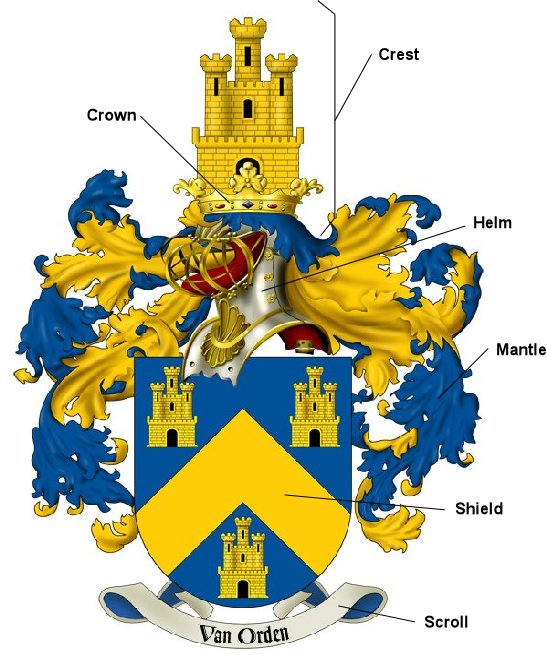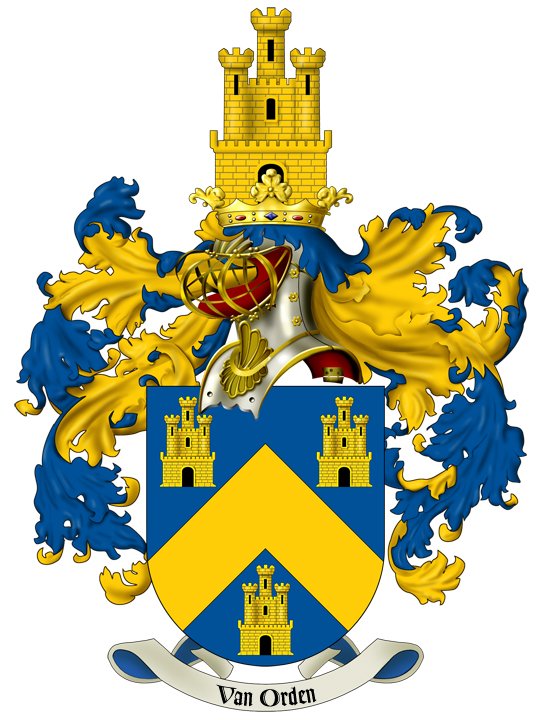

by Russell Bateman
Heraldry deals with ancestral lines especially as they have implications for lineage, titles, crests and coats of arms. Indeed, heraldry is complicated enough that there actually exist professional heraldists. Except for a very tiny number of official heraldists, the majority make a living by selling heraldry services, such as researching family coats of arms for individuals, schools, communities, etc. Herald, the term, comes from French, héraut d’armes, a public officer whose function was to carry messages, particularly of declaration of war, or to announce the arrival of high persons such as the king. John the Baptist was, in effect and in symbolism, the herald of Jesus Christ.
Coats of arms are a delightful panache for family genealogists, a sort of icing on the family cake. A family may gather together pedigrees, photos and histories, but inevitably will seek some concise seal upon or banner over their family history work. A coat of arms is a graphic representation that lends a special cachet to a family’s work and so it is highly desirable to use one on the cover of a book, family stationery, or the family webpage.
I am a new-comer to this field. What I have written here is all I have been able so far to learn in casual research over the last two or three years. If you know something I don’t, please do not hesitate to share it with me, Russell Bateman.
We have to wonder what the history of the family coat of arms is. What legitimacy does a coat have? How can it be determined what a family’s coat is? What if there is more than one coat for a given name?
In some countries there are even laws, largely ignored as near as I can tell, that insist that only the direct line of male heirs can use the coat of arms granted to an ancestor. The United States of America has no such laws. The ideas of liberty, equality and fraternity that have grown out of the American, French and other revolutions make it unthinkable that any person or family be undeserving of respect, dignity and the right to think of himself or itself as special. This feeling is all the more acute on the part of the individual for his own family.
Most Americans of European descent probably have a family name for which there is already a coat of arms even if, strictly speaking, they have no official or formal right to display that coat.
The coats of arms originated in the Middle Ages as a way of distinguishing individual combattants, particularly wealthy knights, on the field of battle. You had to be wealthy to be able to afford the necessary armor of a knight and wealthier still to have it decorated and maintained in a distinctive way by which others could recognize you—including others who knew your coat of arms, but did not know you personally. There are tales according to which combattants were mistaken in the field. William the Conqueror reportedly lifted his helmet at one point in the battle of Hastings in order to rally his troups among whom the rumor of his death had begun to spread.
Authentic or historic coats of arms contain a graphic representation of the deeds or "gests" (an ancient French word for the deeds of a knight) of the originating ancestor. As a knight became experienced (mostly, as he survived), he gained recognition for acts of valor in the service of his lord and that lord granted him honor, which honor might be reflected in his coat of arms much as a military officer or soldier today receives ribbons and medals to display upon his person for services rendered to his country.
Historic or official coats of arms and their elements are recorded in long-established and reverenced documents such as Burke’s General Armory and Reitstap’s Armorial General. These are are two of the resources that heraldists use in researching a family’s coat of arms. Sometimes coats of arms already have surviving graphical representations, but most of the time, the heraldist recreates the coat of arms from a description written in a strange language mix of French, English and German terms. Reputable heraldists will offer your coat of arms in some graphic medium after careful research including interpreting the description of your authentic coat if extant.

What if my family has no coat? This the case of the Van Orden family. Why? Because our ancestors chose to keep the van Naarden (then Van Orden) patronymic instead of returning to Mabille de Nevy as some of Pierre’s decendants have done. I communicated to David Humphreys, a Welsh heraldist whose services I’ve used a couple of times before, the coat that some of our family had been using (reproduced here on the right) and he created a heraldic description from it. An authentic description is called a "blazon" so named because when a knight appeared in a tourney, a blast was given on trumpets and a herald named aloud and described the arms on the knight’s shield and the surcoat worn over his armor.
The Van Orden coat of arms is described in the following heraldic language:
| Name and origin: | Van Orden of Naarden, the Netherlands. | |
| Shield: | Azure, a chevron between three towers or. | |
| Crest: | Out of a ducal coronet a tower or. |
In English we would say, "A shield of blue with a chevron separating three castles/towers in gold. The crest consists of a castle/tower arising from a duke’s crown all in gold." (or is French for gold.) Anything else is optional and left to the imagination or artistic talent of the heraldist.
With the disappearance of warfare the way it was done on the medieval battlefield, the coat of arms has long been a largely decorative phenomenon.
The coat of arms consists of the following elements (refer to the Van Orden coat of arms below):

Let’s be frank. The depth of our coat of arms is not that of a medieval family. While the origin of the coat we use now is not entirely known (it was done or commissioned by Melvin Van Orden of Blackfoot), it is a good coat. The only element of questionable appropriateness would appear to be the ducal crown. Was Pierre Mabille de Nevy a duke or the decendant of one? It matters not. Modern coats are whatever the family decides to adopt. They serve as ornement and as a rallying symbol for the family.
Let’s examine the elements of our coat of arms including their significance.
What is upon the shield is known as "the charge," usually an animal, but sometimes something else like a hand, arm, foot, sceptre, millstone, harp, etc.
The main charge upon our shield is three castles which usually stand for an ancestor having owned and defended one or taken one by force from an enemy. Indeed, the latter would echo our slogan, Manu forti which is in Latin, "by means of a strong hand."
I prefer to view the castles as signifying that our French ancestor held titled land whatever his actual grade was. Certainly the stories about him make us believe that he was a trusted officer of his lord.
The chevron on our shield, an element known as an "ordinary," stands for protection. The color gold (or in heraldic terms) stands for generosity while blue (azure) for loyalty and truth.
Perhaps the Van Orden coat of arms is as much a symbol to live up to as the expression of ancestral laurels.